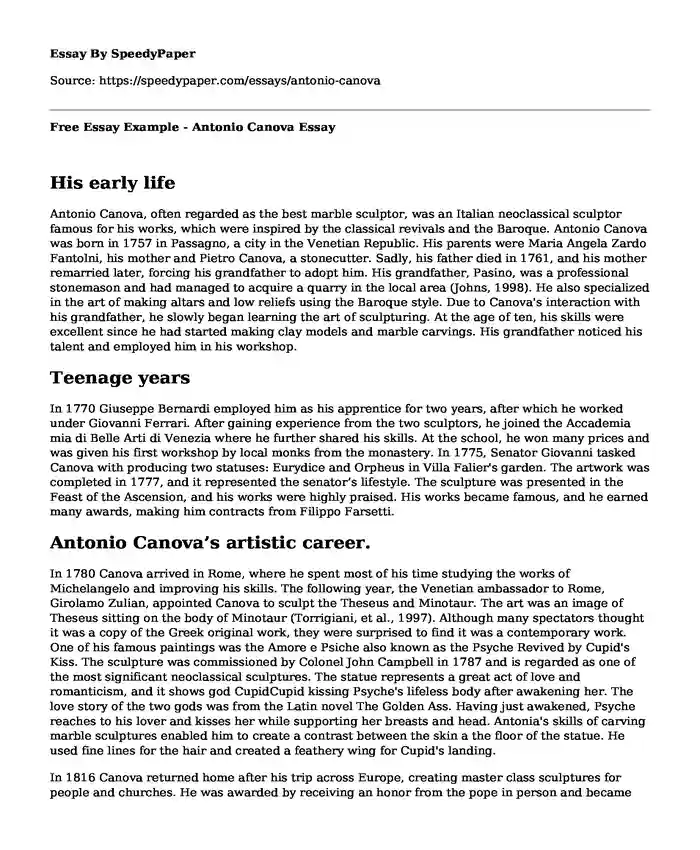
| Essay type: | Rhetorical analysis essays |
| Categories: | Culture Biography Sculpture Personal leadership |
| Pages: | 3 |
| Wordcount: | 656 words |
His early life
Antonio Canova, often regarded as the best marble sculptor, was an Italian neoclassical sculptor famous for his works, which were inspired by the classical revivals and the Baroque. Antonio Canova was born in 1757 in Passagno, a city in the Venetian Republic. His parents were Maria Angela Zardo Fantolni, his mother and Pietro Canova, a stonecutter. Sadly, his father died in 1761, and his mother remarried later, forcing his grandfather to adopt him. His grandfather, Pasino, was a professional stonemason and had managed to acquire a quarry in the local area (Johns, 1998). He also specialized in the art of making altars and low reliefs using the Baroque style. Due to Canova's interaction with his grandfather, he slowly began learning the art of sculpturing. At the age of ten, his skills were excellent since he had started making clay models and marble carvings. His grandfather noticed his talent and employed him in his workshop.
Teenage years
In 1770 Giuseppe Bernardi employed him as his apprentice for two years, after which he worked under Giovanni Ferrari. After gaining experience from the two sculptors, he joined the Accademia mia di Belle Arti di Venezia where he further shared his skills. At the school, he won many prices and was given his first workshop by local monks from the monastery. In 1775, Senator Giovanni tasked Canova with producing two statuses: Eurydice and Orpheus in Villa Falier's garden. The artwork was completed in 1777, and it represented the senator’s lifestyle. The sculpture was presented in the Feast of the Ascension, and his works were highly praised. His works became famous, and he earned many awards, making him contracts from Filippo Farsetti.
Antonio Canova’s artistic career.
In 1780 Canova arrived in Rome, where he spent most of his time studying the works of Michelangelo and improving his skills. The following year, the Venetian ambassador to Rome, Girolamo Zulian, appointed Canova to sculpt the Theseus and Minotaur. The art was an image of Theseus sitting on the body of Minotaur (Torrigiani, et al., 1997). Although many spectators thought it was a copy of the Greek original work, they were surprised to find it was a contemporary work. One of his famous paintings was the Amore e Psiche also known as the Psyche Revived by Cupid's Kiss. The sculpture was commissioned by Colonel John Campbell in 1787 and is regarded as one of the most significant neoclassical sculptures. The statue represents a great act of love and romanticism, and it shows god CupidCupid kissing Psyche's lifeless body after awakening her. The love story of the two gods was from the Latin novel The Golden Ass. Having just awakened, Psyche reaches to his lover and kisses her while supporting her breasts and head. Antonia's skills of carving marble sculptures enabled him to create a contrast between the skin a the floor of the statue. He used fine lines for the hair and created a feathery wing for Cupid's landing.
In 1816 Canova returned home after his trip across Europe, creating master class sculptures for people and churches. He was awarded by receiving an honor from the pope in person and became the president of the Accademia di San Luca. To honor himself, he made a sculpture of himself and financed the whole design and participated in manual labor. He continued to make many sculptures across the world with recommendations from renowned world leaders. Unfortunately, he passed away on 13 October 1822, and the body was buried in the Temple Canoviano. He was 64 years old, and his memorial was a grand ceremony attended by people from all lifestyles.
Reference
Johns, C. M. (1998). Antonio Canova and the politics of patronage in revolutionary and Napoleonic Europe. Univ of California Press.
Torrigiani, P., Rabiti, A. L., Bortolotti, C., Betti, L., Marani, F., Canova, A., & Bagni, N. (1997). Polyamine synthesis and accumulation in the hypersensitive response to TMV in Nicotiana tabacum. The New Phytologist, 135(3), 467-473.
Cite this page
Free Essay Example - Antonio Canova. (2023, Aug 29). Retrieved from https://speedypaper.net/essays/antonio-canova
Request Removal
If you are the original author of this essay and no longer wish to have it published on the SpeedyPaper website, please click below to request its removal:
- Abraham Lincoln's Leadership Style Essay Sample
- Anthem by Ayn Rand - A Free Literary Essay
- American Literature Essay Sample: The Open Boat and To Build a Fire
- Working in Paradise - Free Essay about Google Campus
- Free Essay on Application and Use of Stakeholder Management Approach
- Free Paper Sample on Significance of the Poem If by Kipling and Hindu Wedding Rituals
- Unveiling Racial Prejudice: Analyzing Faulkner's 'That Evening Sun' - Paper Example
Popular categories




